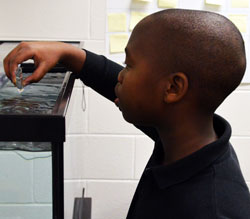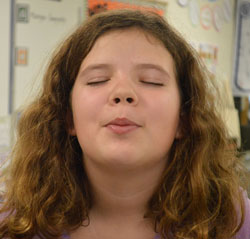At the bottom of the fish tank lay more than 180 pink-ish eggs that, every now and then, wiggled. One teeny just-hatched fish squirmed.
“They shake a lot. They are trying to get out,” explained fourth-grader Barbara Hoolihan.
The salmon eggs were nearing their time to hatch, after which they will still carry their yolk sacs for about a month. Looking closely, fish eyes were visible inside the eggs.
Fourth-grader Loghan Sterkenburg recited the life cycle of the chinook salmon: “Eggs, eyed-egg, alevin, fry, parr, smolt and adult.”

Students in Discovery Elementary School’s P.E.A.K.S gifted and talented program are raising the fish until they are ready — about 3 or 4 centimeters — to release in May into a local tributary that leads to the Grand River. Because salmon imprint their migration path, students hope they return as adults to lay their eggs.
“I like seeing how they develop,” said fourth-grader Lawson Love. “Maybe I might find out how they evolve and have more questions about how they adapt to stuff.”
Adding Their Fish to Michigan Waters
Teacher Lilian Patrick received the eggs after a field trip with students to the Wolf Lake Fish Hatchery in Mattawan, in participation with the Salmon in the Classroom Program. The hatchery produces steelhead, chinook salmon, walleye and Great Lakes muskellunge for both inland and Great Lakes waters. Patrick also led the project last school year, ultimately releasing 109 fish into the stream.

Patrick said she always wanted a classroom pet, and thought raising fish was a great way to bring animals into her curriculum as a science project.
“You don’t usually get to see the beginning life stages for fish,” she said. “You can kind of imagine what baby animals look like when they are born, but with fish I don’t really get those same experiences. They still have their egg sacs attached, and they are still on the bottom of the tank.”
Students are caring for the fish by monitoring temperature and ammonia, pH and nitrate levels.
“I’m excited to see how much we feed them when they don’t have their egg sacs anymore,” said fourth-grader John Bizimana.
Students said they already feel connected to their classroom fish. “They are relying on us to feed them,” Loghan said.
CONNECT












